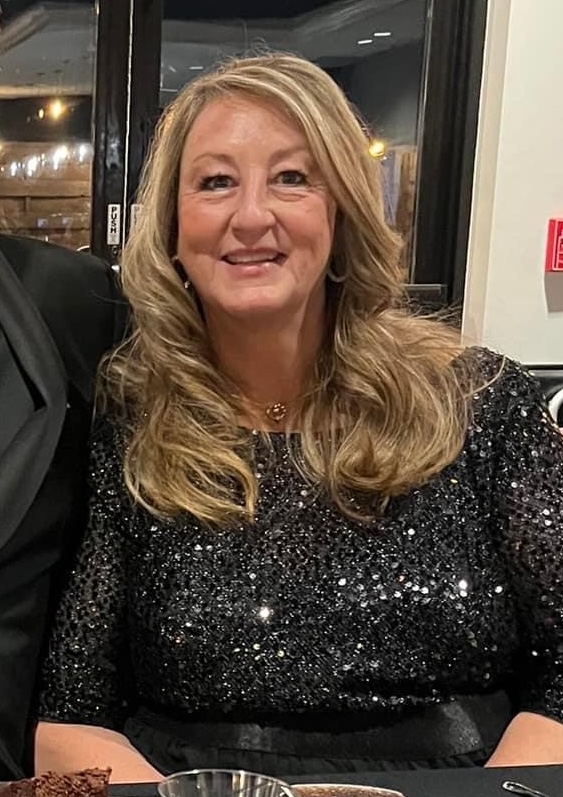The alarm bell started ringing for Cassandra Knolinski when she had to borrow her 82-year-old mother’s scooter.
She was just 57 years old at the time and had been struggling with knee pain for years. At first, the pain was manageable. She’d take over-the-counter medication to help get through her day as a fifth-grade robotics teacher and assumed her knee pain would eventually get better.

Yet over the course of the next few years, her symptoms got progressively worse. Knolinski (pictured at right) had to start using crutches to walk. She stopped swimming and dancing—activities she loved—and found herself saying “no” to outings with friends, her two daughters, and her husband because her discomfort level was that high. “I’m a very social person, so this really took a toll on my mental health,” she says. “Looking back now, it’s clear that I was depressed.”
When surgeons mentioned the possibility of a knee replacement, Knolinski was hesitant—mostly because she feared a long recovery time.
But once she needed to use her mom’s scooter to get around at work, Knolinski realized something needed to change. When a trip she’d planned to Italy with her husband was canceled—and Knolinski was relieved, not disappointed—she started wrapping her head around having the knee replacement surgery.
Total knee arthroplasty, reimagined
Knolinski made an appointment with an orthopedic surgeon to see if she was a candidate for total knee arthroplasty, one of the most common joint procedures performed in the U.S. each year.2 Not only was she a candidate, but the physician asked Knolinski if she’d like to be the first patient in Indiana to have the procedure done via robotic-assisted surgery.4 One of the biggest benefits, her surgeon told her, was that robotic-assisted technology may provide faster recovery time from knee replacement surgery.5,6
Knolinski scheduled the surgery for later that month, and in early spring of 2022, Knolinski received an ATTUNE™ Knee System implant using VELYS™ Robotic-Assisted Solution.
The ATTUNE Knee System is designed to optimize how the knee replacement feels and moves , and to work in harmony with the knee muscles and ligaments to increase stability and reduce pain compared to similiar knee implants.7-11 Not to mention, in one study, physical therapists noted that ATTUNE Knee patients had significantly greater range of motion than other knee replacement patients, both at two and six weeks post-surgery.12*
What’s more, years of research went into studying gender differences in knee anatomy and how they might impact the design of the ATTUNE implant, and those findings led to more implant size offerings for surgeons to use in their patients.13

The Johnson & Johnson MedTech team who worked on ATTUNE asked themselves: What’s next? The answer: Evolve the procedure and develop a robotic-assisted solution surgeons could use to place the ATTUNE knee implant in patients with more accuracy and ease.
That’s how the VELYS Robotic-Assisted Solution was developed—it uses a variety of advanced technologies to provide the surgeon with the information and tools they need to perform a precise knee replacement surgery personalized for a specific anatomy.14, 15 An infrared camera and optical trackers in VELYS allow orthopaedic surgeons to gather crucial information about a patient’s specific knee anatomy, remove damaged bone with precision and understand exactly how the knee implant is fitting.16
“What’s really cool about VELYS is that surgeons don’t have to take a trial-and-error approach,” says Patrick Courtis, Ph.D., a Systems Engineering Manager, Orthopaedic Robotics, at Johnson & Johnson MedTech. “In my experience, I’ve observed that they can see the impact of how the implant position is going to affect the soft tissue, and they can position it in a way that avoids having to alter the patient’s soft tissue to match the implant.”
Getting moving again
Last year Knolinski retired and is now more active than she can remember being in a long time. She swims a mile every day at her local YMCA and walks for at least 40 minutes. She sees friends without worrying about how much she’ll have to walk or how many stairs she may have to climb. She and her husband also went on that two-week trip to Italy that they’d had to cancel multiple times due to Knolinski ’s knee pain, and they have trips to Iceland and Greece planned for the coming months.

While being the first patient in Indiana to have a knee replacement using the VELYS robotic-assisted surgery felt like a coincidence at first, now Knolinski is enthusiastic about the power of technology—and she’ll actively search for a surgeon who uses robotics for all future surgeries she may need. In fact, when the time comes for a knee replacement on her other knee—something that’s likely going to be needed within the next few years—having it done using ATTUNE and the VELYS Robotic-Assisted Solution will be a top priority.
“I lost years of my life before my knee replacement,” says Knolinski. “I would have the surgery again in a heartbeat.”
Hear more from Cassandra about her surgery
Go here
* Based on a study comparing the ATTUNE™ Knee System vs. the SIGMA™ CR150 Knee System.
References:
1 "Joint Replacement Surgery," American College of Rheumatology. Accessed November 4, 2024.https://rheumatology.org/patients/joint-replacement-surgery.
2 Hamilton WG, Brenkel IJ, Barnett SL, et al. Comparison of Existing and New Total Knee Arthroplasty Implant Systems From the Same Manufacturer: A Prospective, Multicenter Study. J Am Acad Orthop Surg Glob Res Rev. 2021;5(12):e21.00136. Published 2021 Dec 15. doi:10.5435_JAAOSGlobal-D-21-00136.
3 Indelli PF, Pipino G, Johnson P, Graceffa A, Marcucci M. Posterior-stabilized total knee arthroplasty: a matched pair analysis of a classic and its evolutional design. Arthroplast Today. 2016;2(4):193-198. Published 2016 Aug 21. doi:10.1016_j.artd.2016.05.002.
4 “Maconaquah student names new knee surgery robot.” Kokomo Tribune. June 4, 2022. https://www.kokomotribune.com/news/maconaquah-student-names-new-knee-surgery-robot/article_ddda4e50-e2b4-11ec-b8ac-5b0027be7270.html
5 Alton TB, Chitnis AS, Goldstein L, et al. Resource utilization and costs for robotic-assisted and manual total knee arthroplasty - a premier healthcare database study [published online ahead of print, 2023 Mar 2]. Expert Rev Med Devices. 2023;1-9. doi:10.1080_17434440.2023.2185138
6 Clatworthy M. Patient-Specific TKA with the VELYS Robotic-Assisted Solution. Surg Technol Int. 2022;40.
7 Hamilton WG, Brenkel IJ, Barnett SL, et al. Comparison of Existing and New Total Knee Arthroplasty Implant Systems From the Same Manufacturer: A Prospective, Multicenter Study. J Am Acad Orthop Surg Glob Res Rev. 2021;5(12):e21.00136. Published 2021 Dec 15. doi:10.5435_JAAOSGlobal-D-21-00136.
8 Indelli PF, Pipino G, Johnson P, Graceffa A, Marcucci M. Posterior-stabilized total knee arthroplasty: a matched pair analysis of a classic and its evolutional design. Arthroplast Today. 2016;2(4):193-198. Published 2016 Aug 21. doi:10.1016_j.artd.2016.05.002.
9 Fitzpatrick CK, Clary CW, Rullkoetter PJ. The influence of design on TKR mechanics during activities of daily living. Poster presented at: Orthopaedic Research Society Annual Meeting; February 4-7, 2012; San Francisco, CA; poster 2034.
10 Lim D, Kwak DS, Kim M, et al. Kinematically aligned total knee arthroplasty restores more native medial collateral ligament strain than mechanically aligned total knee arthroplasty. Knee Surg Sports Traumatol Arthrosc. 2022;30(8):2815-2823. doi:10.1007/s00167-021-06680-y
11 Courtney PM, Lee GC. Early Outcomes of Kinematic Alignment in Primary Total Knee Arthroplasty: A Meta-Analysis of the Literature. J Arthroplasty. 2017;32(6):2028-2032
12 Clatworthy, M. (2015). An Early Outcome Study of the ATTUNE™ Knee System vs. the SIGMA™ CR150 Knee System. DePuy Synthes Companies White Paper.
13 Asseln M, Hänisch C, Schick F, Radermacher K. “Gender differences in knee morphology and the prospects for implant design in total knee replacement.” Knee. 2018 Aug;25(4):545-558. doi: 10.1016/j.knee.2018.04.005. PMID: 29773405.
14 Clatworthy M. Patient-Specific TKA with the VELYS Robotic-Assisted Solution. Surg Technol Int. 2022;40.7
15 Doan, G.W., et al., Image-Free Robotic-Assisted Total Knee Arthroplasty Improves Implant Alignment Accuracy: A Cadaveric Study. J Arthroplasty, 2022. 37(4): p. 795-801.
16 Huang P, Cross M, Gupta A, Intwala D, Ruppenkamp J, Hoeffel D. “Early Clinical and Economic Outcomes for the VELYS Robotic-Assisted Solution Compared with Manual Instrumentation for Total Knee Arthroplasty.” J Knee Surg. 2024 Oct;37(12):864-872. doi: 10.1055/a-2343-2444. Epub 2024 Jun 12. PMID: 38866046; PMCID: PMC11405097.
Important Information: Prior to use, refer to the instructions for use supplied with the device(s) for indications, contraindications, side effects, warnings and precautions.
© Johnson & Johnson and its affiliates 2024.US_DPS_ALLD_392973
.jpg&w=3840&q=75)